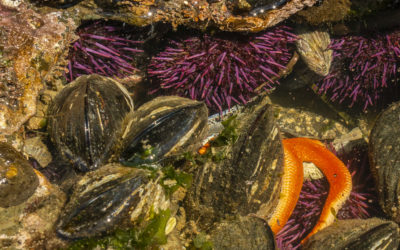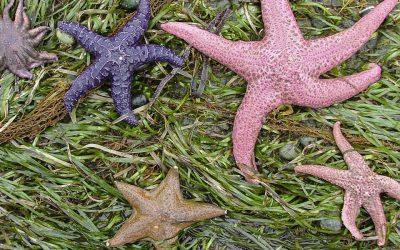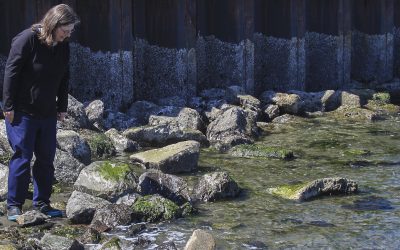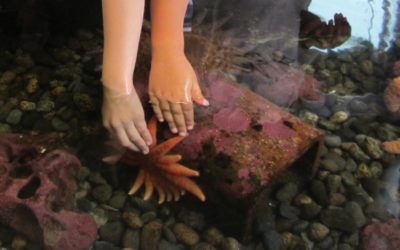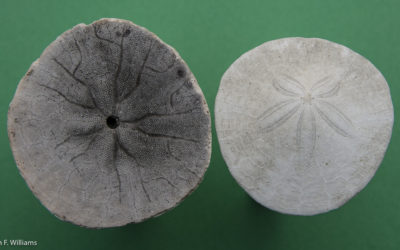Sea Cucumbers
by Paul Pegany
Photos & video by John F. Williams, except where noted

Sea Cucumbers
By Paul Pegany, Summer 2019
Photos & video by John F. Williams except where noted
Sea cucumbers are elongated creatures with a mouth on one end and an anus on the other. They appear soft, squishy, and somewhat resemble a bumpy, rusty-colored pickle. But, these unassuming creatures play a vital role in the tidal environment: they are the clean-up crew.
Much like earthworms on land, sea cucumbers slowly move across the seafloor scooping up detritus and other organic matter, breaking it down, and expelling it so that bacteria can continue the decomposition process. This skill has earned the sea cucumber the humble sobriquet of “vacuum cleaner of the sea” or “earthworm of the seafloor.” True to its earthworm comparison, sea cucumbers accomplish this task slowly, with a top speed around twelve feet per day.

But, while their job might sound a bit undesirable, sea cucumbers can perform a trick that most other animals cannot: they breathe through their anus! This “butt breathing” is performed as the cucumber pulls in water through its anus and sends it to an interior respiratory tree. From here, the oxygen is distributed to the cells of the animal and expelled back through the anus.
Watch red and California sea cucumbers in action. It looks better when viewed full-screen.
But it gets even better. Recent research (Jaeckle and Strathmann) has indicated that the sea cucumber can also take in food through its anus, as well as using anterior tentacles out front. This “multi-tasking butt” discovery not only shows the amazing abilities of echinoderms, but also demonstrates how much more there is to learn about them.
A visitor to a Salish Sea coastline is likely to find at least two main varieties of sea cucumbers. The larger of the two, at one to two feet long, is the California sea cucumber, in commercial demand due to its similarity to a species in Asia. The other common variety is the red sea cucumber (Cucumaria miniata) whose Latin name pretty much sums it up – a miniature version of the sea cucumber.
While California sea cucumbers will be found in sandy areas of the Salish Sea tidal zone and seafloor, red sea cucumbers will be found on rocky shorelines, firmly attached to their substrate. Rather than vacuum up the seafloor like their larger cousins, red sea cucumbers extend ten feeding arms, each covered with branching tentacles, into the water to catch detritus and plankton as the tide comes in.

Red sea cucumbers and sea stars hanging out with anemones in their rocky habitat. Photo by Sharon Pegany
As one might expect of these humble creatures, sea cucumbers have their share of predators. Most notable are their cousins, the sea stars, and in particular, the voracious sunflower star. But, even these “vacuum cleaners of the sea” have their means of defense. When threatened, some species of sea cucumbers can eject some of their internal organs through their anus toward the predator. The sticky organs can entangle and distract the predator while the sea cucumber attempts a quick escape. Fortunately for the sea cucumber, it has the ability to quickly regrow these organs, ready for another attack from their spiny, multi-armed cousins.

Close-up of feeding tentacles of a red sea cucumber. Photo by Sharon Pegany
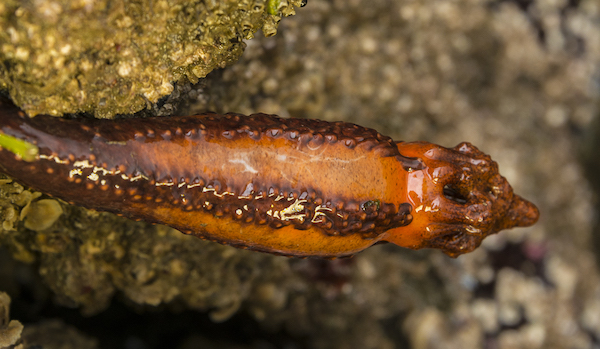

Paul Pegany is a retired elementary educator who has over 30 years of experience in helping students better understand the world around them through science and literature. He splits his time between the Sonoran Desert of Arizona and the forests and seas of the Pacific Northwest. His goal is to help people of all ages better appreciate the beauty of the world, as well as understand the stewardship role that humans play as part of the greater ecosystem. Along with his wife, Sharon, he works to build his own knowledge through coursework and experiences in whichever biome he finds himself.
Table of Contents, Issue #4, Summer 2019
Windows On the Sea
by Nancy Sefton Photos & video by John F. Williams except where notedBy Nancy Sefton, Summer 2019 Photos & video by John F. Williams except where notedI am bent over double, unable to stop a steady slide down a slope of green slime, tennies soaking, shoulders...
Star Eat Star World
by Paul Pegany Photos & video by John F. Williams except where notedSome of the variety of local sea stars. Photo by Sharon PeganySome of the variety of local sea stars. Photo by Sharon PeganyBy Paul Pegany, Summer 2019 Photos & video by John F. Williams...
Tide Pool Seaweed
by Sara Noland Photos & video by John F. Williams except where notedPhoto by Tom NolandIt's low tide on a lovely Pacific Northwest afternoon. The beach is an expanse of rippled mud and sand, with cobbles and scattered boulders near the water’s edge. I’ve forgotten...
Salish Sea Tide Pools
by Adrianne Lauman, Summer 2019 Photos & video by John F. Williams except where notedBy Adrianne Lauman, Summer 2019 Photos & video by John F. Williams except where notedA tide pool is created when a small amount of marine water is left on a shoreline or in...
Portals of Discovery
by Sharon Pegany Photos & video by John F. Williams except where notedImage courtesy of Feiro Marine Life CenterImage courtesy of Feiro Marine Life CenterBy Sharon Pegany, Summer 2019 Photos & video by John F. Williams except where notedAs spring gives way to...
Postscript 4
by John F. Williams Photos & video by John F. Williams except where notedBy John F. Williams, Summer 2019 Photos & video by John F. Williams except where notedThis issue marks a full year of publishing for Salish Magazine! I've learned a lot of lessons, and a...
FIND OUT MORE
Jaeckle, William and Strathmann, Richard, The Anus as a Second Mouth: Anal Suspension Feeding by an Oral Deposit-Feeding Sea Cucumber (2013). Scholarship. 125.
Pegany, Sharon. See her Pacific Wonder Tracker blog for first-hand glimpses of our Northwest wonders.
California sea cucumber (Parastichopus californicus), Sound Water Stewards, Intertidal Organisms EZ-ID GUIDES

